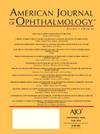Evidence and Consensus-Based Imaging Guidelines in Acute Posterior Multifocal Placoid Pigment Epitheliopathy (APMPPE) - Multimodal imaging in Uveitis (MUV) Taskforce Report 7
IF 4.1
1区 医学
Q1 OPHTHALMOLOGY
引用次数: 0
Abstract
Purpose
To develop consensus-based guidelines on use and interpretation of multimodal imaging in acute posterior multifocal placoid pigment epitheliopathy (APMPPE).
Design
Consensus agreement led by literature, and an expert committee using a nominal group technique (NGT).
Methods
The expert committee for APMPPE performed a thorough review of representative cases of APMPPE. The cases were used to develop guidelines for the diagnosis and follow-up of APMPPE using color fundus photography (CFP), optical coherence tomography (OCT), fundus fluorescein angiography (FFA), indocyanine green angiography (ICGA), fundus autofluorescence (FAF), and OCT angiography (OCTA). Structured NGT-based discussions were used to achieve consensus-based recommendations on imaging characteristics, disease activity, and complications, and subsequently were adopted by a vote of the entire taskforce.
Results
Diagnosis of active APMPPE is characterized by distinctive imaging findings on CFP, and hyper-reflectivity of the ellipsoid zone (EZ), external limiting membrane (ELM), and outer nuclear layer (ONL) on OCT. Choriocapillaris non-perfusion, detectable via early-phase FFA, ICGA or OCTA, is crucial. In the early stages of APMPPE, OCT findings may be unremarkable, making FFA, ICGA, and/or OCTA relevant for the diagnosis. Based on the imaging findings, APMPPE can be classified into 4 stages of activity: choroidal, chorioretinal, transitional, and resolved. Following diagnosis, OCT and OCTA can be used to monitor lesion activity and identify potential complications.
Conclusions
MUV imaging criteria enable the identification of key diagnostic features for APMPPE, extending the Standardization of Uveitis Nomenclature (SUN) classification. These consensus-based guidelines provide a framework for evaluating disease activity and complications, enhancing diagnostic accuracy and guiding clinical management.
基于证据和共识的急性后部多灶性Placoid Pigment epithelial opathy (APMPPE)影像学指南——葡萄膜炎(MUV)多模态影像学工作组:报告7。
目的:制定基于共识的指南,在急性后多发灶类胎盘色素上皮病(APMPPE)中使用和解释多模态成像。设计:由文献和专家委员会领导的共识协议,使用名义上的小组技术(NGT)。方法:APMPPE专家委员会对具有代表性的APMPPE病例进行了全面的审查。应用彩色眼底摄影(CFP)、光学相干断层扫描(OCT)、眼底荧光素血管造影(FFA)、吲哚菁绿血管造影(ICGA)、眼底自体荧光(FAF)和OCT血管造影(OCTA),为APMPPE的诊断和随访制定指南。结构化的基于ngt的讨论用于就成像特征、疾病活动性和并发症达成基于共识的建议,随后由整个工作组投票通过。结果:活动性APMPPE的诊断特点是CFP的独特影像学表现,oct的椭球区(EZ)、外限制膜(ELM)和外核层(ONL)的高反射率,通过早期FFA、ICGA或OCTA检测绒毛膜非灌注是至关重要的。在APMPPE的早期阶段,OCT的表现可能不显著,因此FFA、ICGA和/或OCTA与诊断相关。根据影像学表现,APMPPE可分为四个活动阶段:脉络膜、脉络膜视网膜、过渡期和消退期。诊断后,OCT和OCTA可用于监测病变活动并识别潜在的并发症。结论:MUV成像标准能够识别APMPPE的关键诊断特征,扩展了葡萄膜炎命名法(SUN)分类的标准化。这些基于共识的指南为评估疾病活动性和并发症、提高诊断准确性和指导临床管理提供了框架。
本文章由计算机程序翻译,如有差异,请以英文原文为准。
求助全文
约1分钟内获得全文
求助全文
来源期刊
CiteScore
9.20
自引率
7.10%
发文量
406
审稿时长
36 days
期刊介绍:
The American Journal of Ophthalmology is a peer-reviewed, scientific publication that welcomes the submission of original, previously unpublished manuscripts directed to ophthalmologists and visual science specialists describing clinical investigations, clinical observations, and clinically relevant laboratory investigations. Published monthly since 1884, the full text of the American Journal of Ophthalmology and supplementary material are also presented online at www.AJO.com and on ScienceDirect.
The American Journal of Ophthalmology publishes Full-Length Articles, Perspectives, Editorials, Correspondences, Books Reports and Announcements. Brief Reports and Case Reports are no longer published. We recommend submitting Brief Reports and Case Reports to our companion publication, the American Journal of Ophthalmology Case Reports.
Manuscripts are accepted with the understanding that they have not been and will not be published elsewhere substantially in any format, and that there are no ethical problems with the content or data collection. Authors may be requested to produce the data upon which the manuscript is based and to answer expeditiously any questions about the manuscript or its authors.

 求助内容:
求助内容: 应助结果提醒方式:
应助结果提醒方式:


